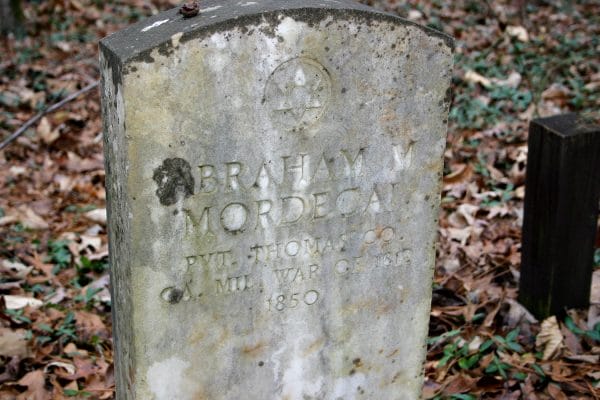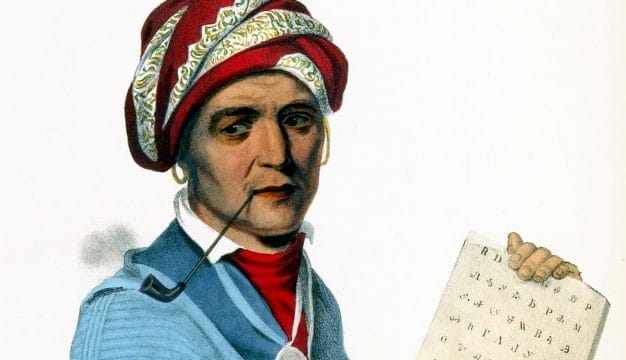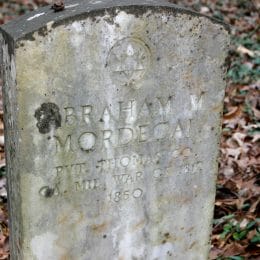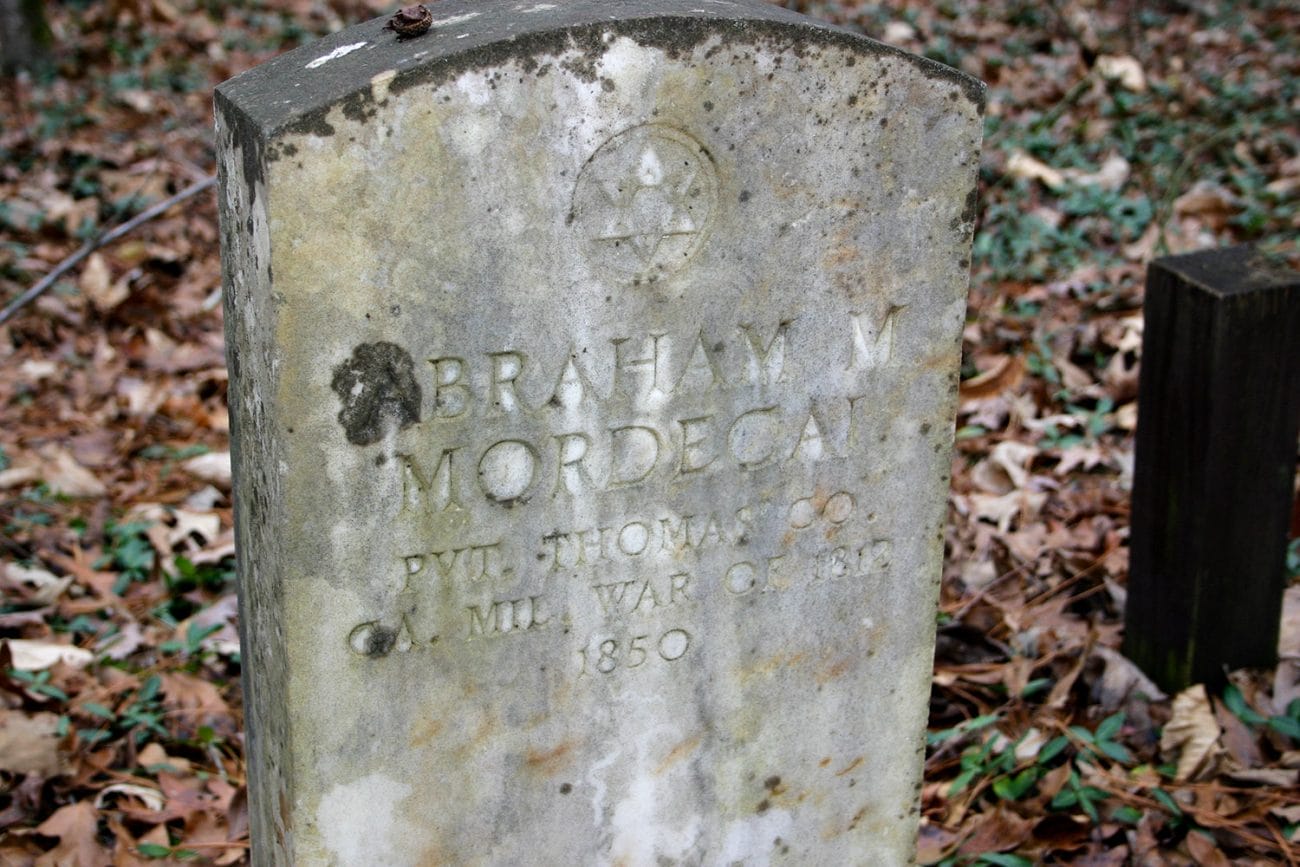Abraham Mordecai
Abraham Mordecai (1755-1850) was among the earliest white residents, and likely the first Jewish resident, of what is now Alabama. Mordecai played a role in virtually all of the events that shaped the Southeast, including the American Revolution, the War of 1812, and the Creek War of 1813-14, and in Alabama’s early statehood and economic development. During his long life, he was variously a negotiator between the Creeks and federal and state agents, a trader, a military guide and scout, and an early founder of the cotton industry around Montgomery.
Mordecai was born in Philadelphia, Pennsylvania, on October 24, 1755, to a family of merchants. Nothing is known of his early life, but he apparently served in some capacity in the American Revolution. By 1783, he had settled in Georgia and established a trading business at Line Creek (in present-day Chambers County) with the Creek town at Cusseta, near what is now Fort Moore (formerly Fort Benning) on the Alabama-Georgia border. Mordecai served as a go-between for the Creeks, trading furs, medicinal plants, and other items for European goods and utensils acquired in Pensacola, Savannah, and other cities along the southeastern seaboard. Mordecai married a Creek woman, believing (along with many others during this period) that Native Americans were descendants of one of the fabled Lost Tribes of Israel. In fact, many sources indicate that he initially attempted to speak with the Creeks in Hebrew, in the belief that their language was actually a dialect of his language. He became known among the Creeks as Muccose, or Little Chief.
In 1785, Mordecai moved with his family to the Creek town of Econochaca (also known as Holy Ground), along the banks of the Alabama River, in present-day Montgomery. He again set up a trading business among the nearby Creeks and Choctaws, being one of the few non-Indians in the area at the time. In the 1790s, the federal government initiated what was known as the “plan of civilization”, which aimed to encourage Native Americans to give up hunting and gathering and adopt farming and manufacturing as their livelihood, with the ulterior motive of acquiring their vast hunting lands. Toward that end, Benjamin Hawkins, administrator of the plan, enlisted Mordecai’s aid in 1802 to establish a cotton gin near the Creek towns along the Alabama River, in present-day Montgomery County. Mordecai contracted with Lyons and Barnett, a firm owned by two Jewish families in Georgia, to construct the gin to process cotton that would be grown by the local Creeks and brokered by Mordecai. The gin was built just below the confluence of the Coosa and Tallapoosa Rivers, along a trading path that would become part of the route of the Federal Road, near a racetrack owned by Creek leader Charles Weatherford (father of future Red Stick Creek leader William Weatherford) and a tavern known as Milly’s Stand and Old Milly’s Tavern.
Mordecai lived among the Creeks and managed his gin and trading business in relative peace. In one notable incident, however, he angered a local chieftain by offering too much attention to a married woman in his town and apparently lost an ear in the resulting skirmish. He encountered more serious danger when he served with the Georgia Militia during the War of 1812. Upon his return from that service, he was immediately involved in the U.S. effort in the Creek War in 1813, acting as a trail guide through Creek territory for Gen. John Floyd. Allied with the traditionalist faction of the Creek Nation, Mordecai aided the federal troops in tracking down members of the Red Stick faction who had participated in the attack on white settlers and allied Creeks at Fort Mims on August 30. In November 1813, Mordecai led Floyd and his men as well as a force of allied Creeks under William McIntosh to the town of Autossee, located near present-day Shorter, in Macon County. There, the Red Sticks were routed, losing at least 200 men, and the town was burned. Mordecai again guided Floyd’s forces when they set out the following January for Red Stick strongholds at Econochaca and other nearby towns. However, Floyd’s men suffered a major defeat in a surprise Creek attack at Calabee Creek near Autossee. Mordecai also may have been present at the Battle of Horseshoe Bend, when the Red Sticks suffered their final defeat.
After the war, Mordecai returned to his trading store and continued to serve as a cotton broker until 1836, when the Creeks were forcibly removed from their land by the federal government. As a white man, Mordecai remained behind. Some reports indicate that his wife and an unknown number of children removed west to Arkansas and then Oklahoma. Other reports state that his wife had already died by 1836 and his children had moved from the area. In either case, Mordecai moved to Dudleyville, Tallapoosa County, and opened a store there. A popular storyteller in the town, Mordecai was interviewed by a reporter from the Columbus Enquirer in 1843 about his life among the Creeks and his experiences in the Creek War. Four years later, historian Albert James Pickett conducted extensive interviews with Mordecai during his research for his opus History of Alabama: And Incidentally of Georgia and Mississippi from the Earliest Period. Pickett also published an interview with Mordecai in Montgomery’s Flag and Advertiser that same year.
During his final years, Mordecai lived simply in Dudleyville. Many locals stated that he either built his own coffin or had one commissioned several years before his death and ate his meals on it. He died on August 25, 1850 (according to one contemporary newspaper account) and was buried in an unmarked grave in the Dudleyville Cemetery. On July 4, 1933, the Tohopeka Chapter of the Daughters of the American Revolution placed a granite marker on his grave in honor of his service during the American War of Independence.
Further Reading
- Koppman, Lionel. Guess Who’s Jewish in American History. New York: S.P.I. Books, 1992.
- Schafer, Elizabeth D. Lake Martin: Alabama’s Crown Jewel. Charleston, S.C.: Arcadia Publishing, 2003.






